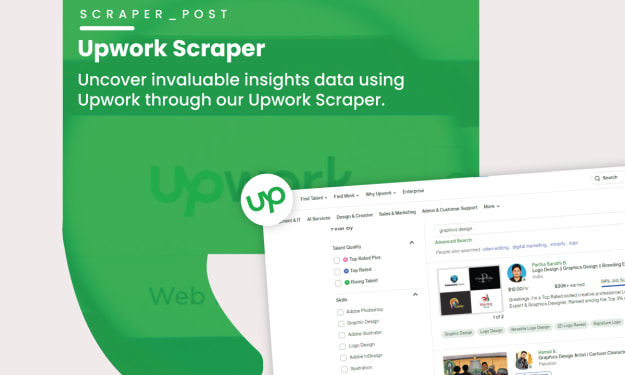How to Quickly Scrape E-commerce Data with Optimum Efficiency?
Mastering the art of quickly scraping e-commerce data with optimum efficiency is crucial for staying ahead in the digital landscape. To elevate your scraping endeavors, explore Real Data API.

How-to-Quickly-Scrape-E-commerce-Data-with-Optimum-Efficiency
Introduction
Some of our previous blog posts explored traditional scraping methods and shared insights on preventing sitemap issues when e-commerce sites alter product placements in designated categories. Now, let's delve into an efficient scraping approach using the "Sitemap.xml Links" selector, known for its remarkable speed in gathering data from e-commerce sites.
This method involves the creation of a specialized "Sitemap.xml Link" selector, systematically navigating through website pages to collect essential information. This innovative approach streamlines the scraping process and minimizes the need to manually create category and subcategory selectors, potentially saving valuable time.
By leveraging the power of the Real Data API, this scraping technique ensures optimal efficiency in gathering data from e-commerce sites. The process commences by crafting a scraper sitemap, setting the stage for a swift and accurate extraction of information from the website's sitemaps. This method is a game-changer, offering a faster and more automated solution for comprehensive data retrieval from diverse e-commerce platforms.
By-leveraging-the-power-of-the-Real-Data-API
Navigating the intricacies of the "Sitemap.xml Links" selector method introduces a challenge: pinpointing the precise location of the required sitemaps within the website structure. Three potential links typically house the sought-after sitemaps. Still, it's crucial to note that there are instances where these valuable data sources might be discreetly concealed, rendering this method ineffective for specific e-commerce sites.
The three potential locations for sitemaps are:
website.com/robots.txt
website.com/sitemap.xml
website.com/sitemap_xml
However, the efficacy of this method hinges on the accessibility of these links. In cases where e-commerce sites strategically obscure their sitemaps, utilizing this method is challenging. The test lies in adeptly uncovering these critical links, ensuring that the scraping process can seamlessly navigate the designated pathways, and extracting the pertinent data for a comprehensive and successful scraping endeavor.
Initially, we inspect the "robots.txt" file by accessing it directly on the website or through the designated "robots.txt" URL.
Initially-we-inspect-the-robots-txt-file-by-accessing
Although the sitemaps are not explicitly listed here, the indication is that they might be located under the "/sitemap.xml" file.
Although-the-sitemaps-are-not-explicitly
This concludes the search in the "robots.txt" file. While it doesn't explicitly list every sitemap, it suggests they may be under the "/sitemap.xml" file. Returning to the developer's tool extension, we'll create the "Sitemap.xml Links" selector, which displays all sitemaps and provides visibility into product sitemaps, offering a comprehensive solution for our scraping needs.
This-concludes-the-search-in-the
With the "Sitemap.xml Links" selector in place, the next crucial step is creating an element selector to guide the scraper in identifying the pages for information retrieval. To achieve this, visiting any product page is imperative. By leveraging a distinctive feature common to all product pages—typically the product title attribute—we can craft an element selector based on the extracted class from the "Inspect" feature.
It is essential to ensure that the "multiple" option is enabled during the selector creation. This critical setting prevents the scraper from returning "null" values for empty pages, guaranteeing accurate data extraction only from the designated product pages. By intricately configuring this element selector, the scraper is primed to discern relevant content, providing a streamlined and effective solution for extracting information from e-commerce websites.
It-is-essential-to-ensure-that-the-multiple-option
The final step involves crafting text selectors to specify the information required for retrieval from the product pages. These selectors pinpoint and extract the essential data for a comprehensive scraping process.
The-final-step-involves-crafting-text-selectors
With the selectors now created, the next step involves reviewing the selector graph to ensure that each component is accurately configured and seamlessly integrated.
With-the-selectors-now-created-the-next-step-involves
If no adjustments or changes are necessary, initiate the scraping process. After a period, once the scraper successfully navigates to the product pages, the scraped data becomes visible, showcasing the effectiveness of the configured selectors in extracting the desired information.
If-no-adjustments-or-changes-are-necessary
While the scraping process may take a bit longer, considering the scraper iterates through all pages listed in the sitemap.xml file, expediting it is an option. Specifically, for this website, you can manually input only the product sitemaps (located in the "/sitemaps.xml" file of the website) separately during the creation of the "Sitemap.xml Links" selector. By doing so, the scraper will bypass miscellaneous pages, effectively streamlining the process.
For example, when creating the "Sitemap.xml Links" selector, you can manually input only the product sitemaps like this:
website.com/product-sitemap1.xml
website.com/product-sitemap2.xml
This strategic adjustment allows you to tailor the scraping focus, ensuring that the scraper exclusively navigates through the product-related pages, optimizing efficiency and reducing the overall duration of the scraping process.
That-concludes-our-guide-on-scraping-using-the
That concludes our guide on scraping using the "Sitemap.xml Links" selector. We trust this information proves beneficial. For additional insights into diverse scraping techniques, explore our blog page or check out our YouTube tutorial videos available on our channel. If you have further queries or seek in-depth tutorials, our blog and videos are valuable resources to enhance your scraping proficiency.
Conclusion
In conclusion, mastering the art of quickly scraping e-commerce data with optimum efficiency is crucial for staying ahead in the digital landscape. By leveraging innovative techniques like the "Sitemap.xml Links" selector, you can streamline the scraping process and extract comprehensive data from diverse e-commerce platforms. The meticulous creation of selectors and element selectors, along with strategic adjustments, ensures precise and swift data retrieval.
As you journey to enhance your scraping capabilities, remember that continuous exploration and adaptation are essential. Stay informed about the latest scraping methodologies and tools. Our blog page and YouTube tutorial videos offer valuable insights if you're eager to delve deeper into various data scraping strategies.
To elevate your scraping endeavors, explore Real Data API, where cutting-edge technologies meet your data extraction needs. Take a proactive step towards scraping success – schedule a demo today and unlock the full potential of efficient e-commerce data scraping with Real Data API. Your journey to optimized data extraction begins now.
Know more : https://www.realdataapi.com/scrape-e-commerce-data-with-optimum-efficiency.php





Comments
There are no comments for this story
Be the first to respond and start the conversation.